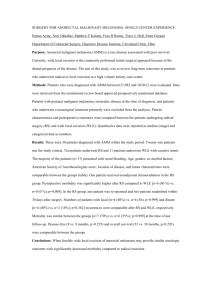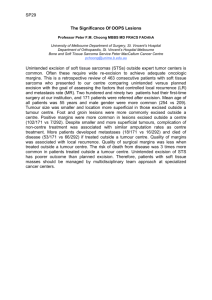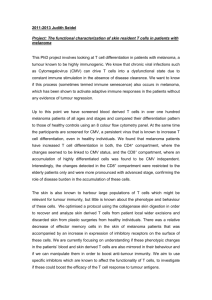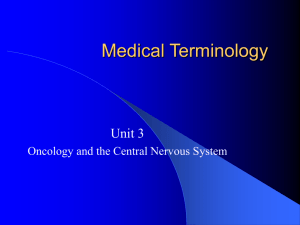Skin tumour
advertisement
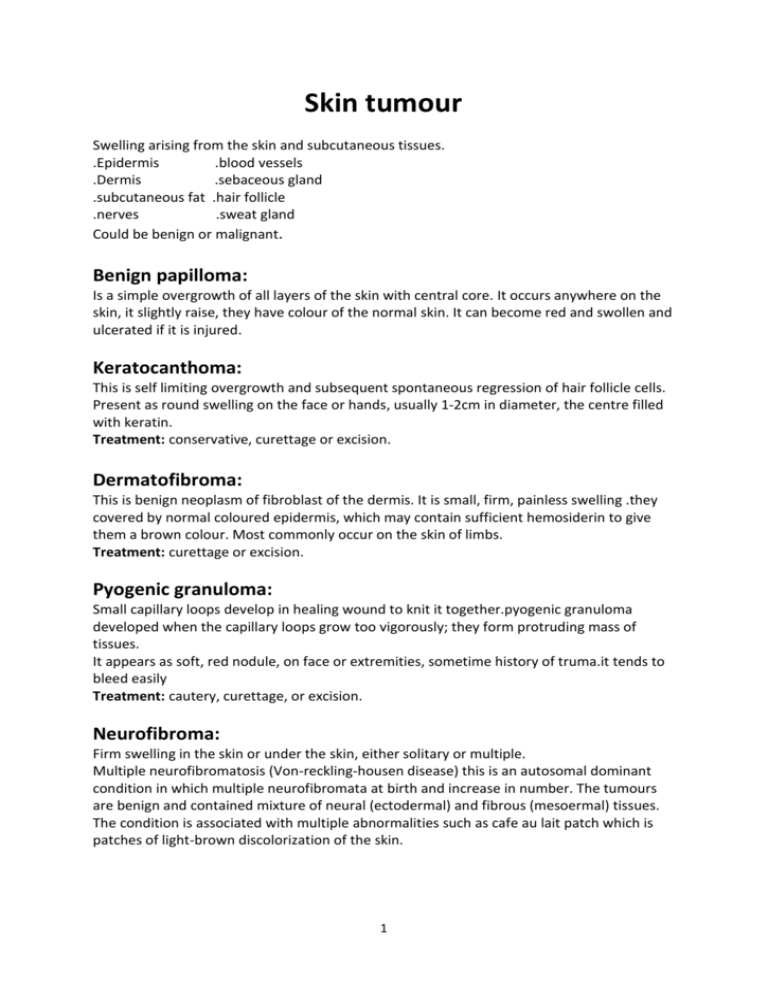
Skin tumour Swelling arising from the skin and subcutaneous tissues. .Epidermis .blood vessels .Dermis .sebaceous gland .subcutaneous fat .hair follicle .nerves .sweat gland Could be benign or malignant. Benign papilloma: Is a simple overgrowth of all layers of the skin with central core. It occurs anywhere on the skin, it slightly raise, they have colour of the normal skin. It can become red and swollen and ulcerated if it is injured. Keratocanthoma: This is self limiting overgrowth and subsequent spontaneous regression of hair follicle cells. Present as round swelling on the face or hands, usually 1-2cm in diameter, the centre filled with keratin. Treatment: conservative, curettage or excision. Dermatofibroma: This is benign neoplasm of fibroblast of the dermis. It is small, firm, painless swelling .they covered by normal coloured epidermis, which may contain sufficient hemosiderin to give them a brown colour. Most commonly occur on the skin of limbs. Treatment: curettage or excision. Pyogenic granuloma: Small capillary loops develop in healing wound to knit it together.pyogenic granuloma developed when the capillary loops grow too vigorously; they form protruding mass of tissues. It appears as soft, red nodule, on face or extremities, sometime history of truma.it tends to bleed easily Treatment: cautery, curettage, or excision. Neurofibroma: Firm swelling in the skin or under the skin, either solitary or multiple. Multiple neurofibromatosis (Von-reckling-housen disease) this is an autosomal dominant condition in which multiple neurofibromata at birth and increase in number. The tumours are benign and contained mixture of neural (ectodermal) and fibrous (mesoermal) tissues. The condition is associated with multiple abnormalities such as cafe au lait patch which is patches of light-brown discolorization of the skin. 1 Lipoma: Slowly growing tumour from fat cells occurs anywhere in the body usually encapsulated. Common tumour in the limbs and trunk. Could be single or multiple. Treatment: excision. Sebaceous gland: The duct of sebaceous gland become blocked, it distended with its own secretion and ultimately become sebaceous cyst. It is firm swelling, adherent to skin and has punctum.occur anywhere in body except i the palm and soles. It may get infection and ulceration. Treatment: excision. Haemangioma and vascular malformation: Anomalies affecting blood vessels and lymphatic. Haemangioma: Benign proliferative neoplasm of unknown aetiology, present in first few weeks at birth and rapidly increase in size during first year of life. Vascular malformation: Capillary malformation (port-wine stain): lesion may be present on anybody part. In face distribution typically fallow the trigeminal nerve distribution. Cavernous malformation: bluish discolorization of skin. Compressible spongy with slow refill, lead to engorgement by dependant position. Lymphatic malformation: classified to micro and macrocystic.head, neck and axilla affected in majority of cases. Arterio-venous malformation: abnormal connection between arteries and vein without intervening capillary bed, presented with thrill, increase body temperature, pulsation and brui.it may developed growth disturbances or skeletal distortion. Treatment: fallow up, surgery, sclerotherapy. Premalignant skin conditions: Disease that can turn o malignant tumours. 1-Bown disease. 2-Paget disease of nipple. 3-Leukoplakia. 4-solar keratosis. 5-Radiodermatitis. 2 6-Chronic scar, ulcer, old burn (marjoline ulcer) 7-Xeroderma pigmentosa. Malignant skin lesions: Basal cell carcinoma: It is the most common malignancy of whites. It arise from A-basal layer epithelial cells. B-external root sheath of hair follicle. It is slowly growing tumor, it doesn’t metastasize but can infiltrate the adjacent tisssues.commonly found in face above line drawn from angle of mouth to lobe of ear. It could occur anywhere, but particularly in the skin of scalp, face, arm and hands. Risk factors: 1-Sun exposure. 2-Adancing age. 3-Faint complexion. 4-Long term exposure to psoralene and UVA therapy (for psoriasis). 5-Arsenic exposure. Type of basal cell carcinoma: 1-Nodular ulcerative type. 2-Superfscail spreading. 3-Sclerosing type. 4-Pigmented type. 5-Basal cell nevous syndrome (Gorlin syndrome). Treatment of basal cell carcinoma: Curettage and desiccation. Surgical excision with margin (0.5 cm). Cryotherapy. Radiation therapy. Mohs fresh frozen section. Dermobrasion and chemical peel. Interferon alpha. Co2 LASER. Local chemotherapy. Sequamous cell carcinoma: It originates from the keratinizing or malpighian (spindle) cell layer of the epithelium. Types of sequmaous cell carcinoma: A-Slow growing: verrucous in nature and exophytic in appearance. 3 B-Rapid growing: more nodular and indurate with early ulceration and invasiveness. Treatment: as for basal cell carcinoma with chemotherapy. Safe margin are more than that of basal cell carcinoma (1-2 cm). Malignant melanoma: It is neoplasm of neural crest derived cells that have differentiated toward melaoncytes. Types of melanoma: 1-superfcial spreading melanoma. 2-Nodular melanoma. 3-Lentiogo maligna melanoma. 4-Acral lentiginous melanoma. 5-Desmoplastic melanoma (variant of neurotopic melanoma). Melanoma thickness grading: Clark level: 1-in situ 2-papillary dermis 3-apillary reticular dermis 4-reticular dermis 5-sucutaneous Breslow depth (mm): <1.00 1.01-2.00 2.01-4.00 >4.00 More depth in mm means more aggressive tumours. Treatment of malignant melanoma: Surgical excision of primary tumour is the mainstay of treatment. For malignant melanoma in situ excision margin will be 0.5cm, for less than 1mm thickness need no more than 1cm. Two cm excision margin for tumour thickness of 1-4 mm. And for more than 4 mm thick tumour, a wider than 2 cm excisonal margin are need. Lymph node dissection (in case of lymph nodes metastasis), radiotherapy, isolated regional perfusion and adjuvant immunotherapy or chemotherapy. 4 5


